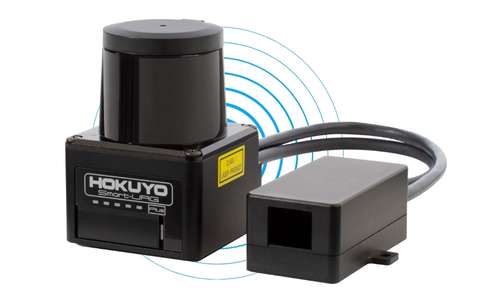Automated Guided Vehicles (AGVs) are at the center of Industry 4.0 goals. It is boosting automation adoption and reliance in every sector, from manufacturing to warehousing. Factors such as increased productivity and lower labor costs are the key reasons behind its embracement.
The AGV market is witnessing monumental growth, with a CAGR of 9.2%, and is expected to reach USD 9.18 billion by 2030. Therefore, a sizable market percentage will look forward to incorporating AGVs into their daily operations.
However, the growth also raises questions about safety. To tackle that, various industries are equipping their AGVs with a 2D LiDAR sensor, which provides real-time detection capabilities to them.
But not all sizes and types of LiDAR sensors fit the intricate structures of the AGVs. The compact size is better, as it supports AGVs. Why? Let’s understand!
Why a 2D LiDAR Sensor Compactness Matters for AGVs
When AGVs are engineered and manufactured, every millimeter and gram of weight makes a huge difference in their performance. 2D LiDAR sensors developed by Hokuyo support these considerations with its small footprint. Their compactness helps AGVs achieve their peak performance.
Compactness Allows Miniaturization
Although AGVs are not always small, the advancements in automation technology are steadily reducing their sizes to make them more agile. For small AGVs, the compactness of a 2D LiDAR sensor matters, as it saves the engineers time and effort because they don’t need to build a dedicated space for it.
Small size also allows for freeing up space for other critical components such as batteries, computing units, payload capacity, and wiring. Therefore, the compactness allows the sensors to be mounted easily without sacrificing any other parts.
Energy Efficient

For example, Hokuyo’s UST-10LXB-H02, an advanced 2D LiDAR scanner, has a compact size with 50×50×70 mm (W×D×H) dimensions. Plus, it comes with Power over Ethernet (PoE) integration that enhances its usability. It receives a 37-57V power supply and sends data through a single cable. Its normal operating power is just 3W, which is remarkably low for continuous scanning without putting a load on the AGVs.
Improved Navigation and Path Planning
The small form factor doesn’t hamper the detection capabilities of the LiDAR sensors. They are capable of delivering high-resolution environmental mapping in real time. Their compactness comes as a benefit, as they can be mounted in exact locations required for precise functionality.
Take UST-10LXB-H02 as an example again, which, despite its small size, has a 40Hz scan frequency. That means it refreshes its environmental data 40 times every second, allowing the AGV to react almost instantly to moving objects or shifting layouts.
It has a small laser spot size that helps capture fine details, such as the edge of a pallet or a workbench. This is paired with a 0.125° angular resolution that ensures even tiny-sized obstacles are detected with pinpoint accuracy.
All these benchmark standard features fit inside a compact body that helps the AGVs navigate the aisles with accuracy and safely, without colliding with anyone.
Enhanced Safety in Dynamic Environments
Talking of safety, the AGVs often work alongside the human workforce in busy areas such as warehouses, manufacturing floors, or production lines. AGVs without 2D LiDAR sensors pose a risk to human life, as they can’t detect their presence and can collide.
To mitigate these risks, a 2 LiDAR sensors collects real-time detection data and feeds it to the AGV's computing system. The moment a foreign presence is detected on the path, the sensor triggers a slowdown command. If the object doesn’t leave the path, it can also trigger a stop function.
Supporting Smarter Fleet Coordination
There might be a few AGVs functioning inside the workplaces today, but as the market grows, their density will also increase significantly. Due to the growth, the risk of collisions increases with more AGVs working simultaneously in a designated space.
However, if they are equipped with the 2D LiDAR sensors, the real-time detection can help avoid collisions. The sensors can help map paths for different AGVs, and when another AGV uses the same path, they can slow down until one of them clears the path or leads in the same direction.
This level of coordination allows the AGV fleets to function more like an organized traffic system with their own eyes and brains. The LiDAR sensors can work even in tight spaces such as narrow aisles of warehouses, automotive plants, distribution hubs, or even inside the cargo.
Equip Your AGVs with Compact Yet Powerful 2D LiDAR Sensors
The small size of LiDAR sensors is not their limitation. Instead, it’s an advantage, as they don’t put pressure on the AGV manufacturers to alter the designs. They can be mounted securely on the AGVs without needing dedicated spaces.
At Hokuyo, we are constantly innovating and engineering a complete range of LiDAR sensors that are setting industry benchmarks. We are backing the ndustrial revolution with sensors that increase productivity and safety in every sector.
Contact us to learn how LiDAR sensors can help your company improve its production capabilities without compromising quality and safety.

 Factory Automation
Factory Automation Logistics Automation
Logistics Automation Process Automation
Process Automation Crane Collision Avoidance
Crane Collision Avoidance LiDAR/Obstacle Detection
LiDAR/Obstacle Detection Safety Laser Scanners
Safety Laser Scanners Optical Data Transmission
Optical Data Transmission Hot Metal Detectors
Hot Metal Detectors Laser Distance Sensor
Laser Distance Sensor Blog
Blog Whitepapers
Whitepapers Case Studies
Case Studies Infographics
Infographics